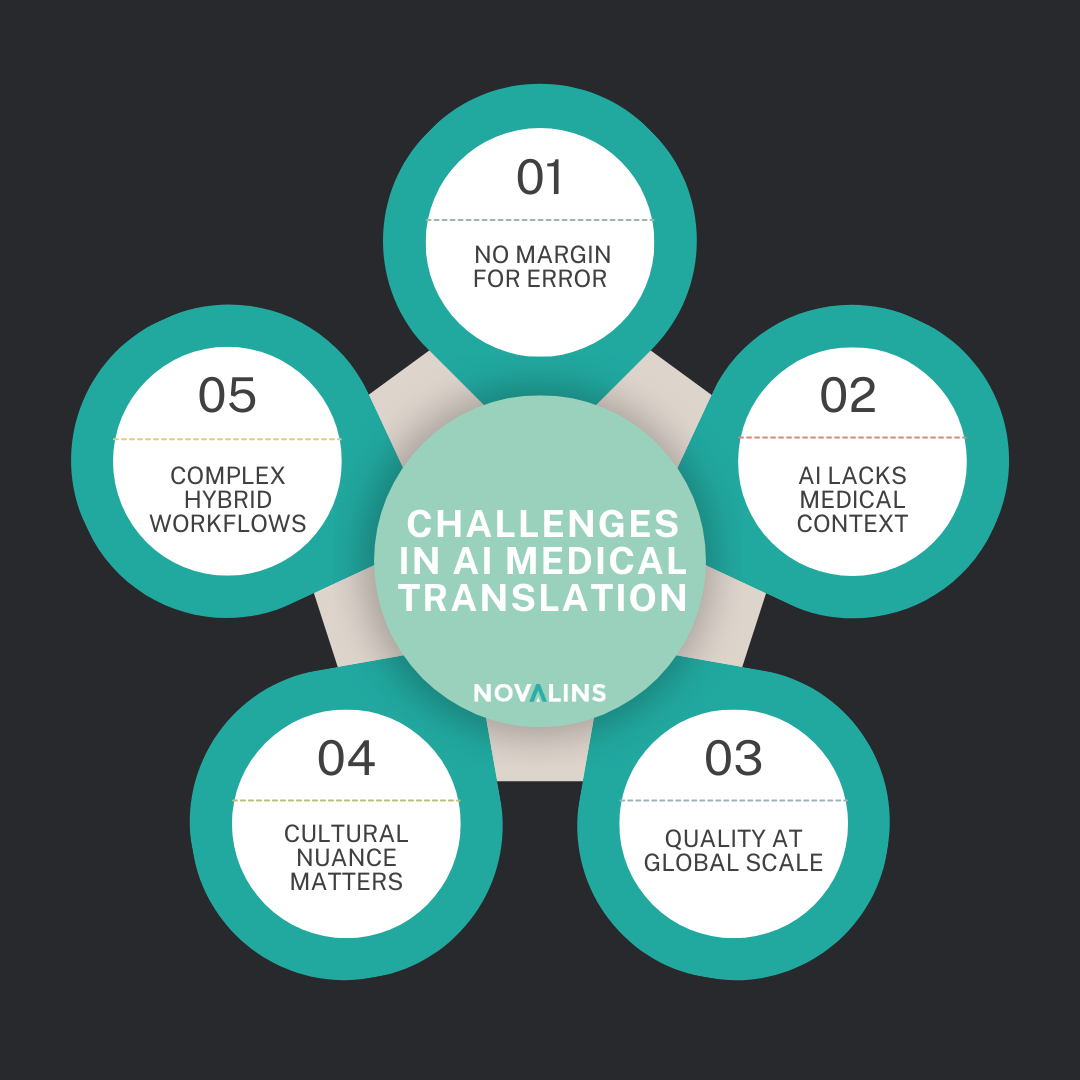From human to AI to multilingual content validation: the evolution of the role of medical translation agencies
The language services industry is undergoing a rapid transformation. Just a few years ago, most companies relied exclusively on human translation to ensure accuracy, nuance, and cultural relevance. Then came the rise of machine translation (MT), which brought dramatic gains in speed and scale—but also raised new challenges around quality and reliability. Today, we are […]
The language services industry is undergoing a rapid transformation. Just a few years ago, most companies relied exclusively on human translation to ensure accuracy, nuance, and cultural relevance. Then came the rise of machine translation (MT), which brought dramatic gains in speed and scale—but also raised new challenges around quality and reliability.
Today, we are witnessing the next stage in this evolution: the integration of artificial intelligence (AI) translation tools, and a growing shift toward multilingual content validation. This shift is especially visible in the medical and healthcare sectors, where accuracy is non-negotiable and new content needs to be rolled out fast, across dozens of languages.

As artificial intelligence (AI) becomes central to translation workflows, companies are rethinking how they ensure quality—especially in the context of high-risk content.
The rise of AI and in-house translation workflows
More and more tech companies are internalizing their translation processes by leveraging AI tools. This gives them significant advantages:
- Faster turnaround times,
- Reduced costs,
- Greater control over their multilingual content pipelines.
However, AI translation—no matter how advanced—still lacks the contextual understanding and domain-specific expertise that is especially critical for healthcare translation accuracy in regulated industries like healthcare.
To compensate for this, companies are building hybrid workflows:
AI translation is followed by in-house post-editing, and then by external validation from specialised medical linguists. This new model signals a shift in how companies view language service providers—not just as executors, but as expert validators and consultants.
An example from our own experience: a wellness app with a new approach
A recent case we encountered perfectly illustrates this shift. A large tech company preparing to launch a wellness app reached out to us. They needed to translate the app content into a wide range of languages to support a global rollout.
Instead of sending their source files to a language service provider (LSP) as they might have in the past, they chose to do things differently. They used AI internally to generate the translations and handled the post-editing themselves. But when it came to validating the medical terminology and ensuring consistency with health-related standards, they turned to us—a specialized medical translation provider.
Their goal was to ensure that the final content would be safe, compliant, and accurate, especially in terms of the medical guidance and terminology used throughout the app. Our role shifted from traditional translation to a more strategic one: validating their content and advising them on the linguistic quality control process.
Why this matters: a glimpse into the future of medical translation
This case is not an exception—it’s a glimpse into the future of medical translation.
We expect to see more companies adopting this hybrid model: using AI and internal teams for speed and scale, while relying on external experts for quality assurance and validation, particularly for high-risk or specialised content.
Why AI alone isn’t enough in healthcare translation becomes especially clear in this context. Multilingual content validation is the cornerstone of trust. It’s no longer just about getting words into another language—it’s about ensuring that those words convey the right meaning, in the right context, with full accuracy. Especially in healthcare, there’s no margin for error.
Conclusion: quality needs collaboration
If a company has the capability to manage machine translation and post-editing internally, that’s absolutely fine. But when it comes to medical content, relying solely on internal processes is risky.
Specialised validation by expert medical translators is essential to ensure that the final content is not only safe, accurate, and compliant with medical standards, but also culturally appropriate. In the medical field, where communication can directly impact patient safety and treatment outcomes, it’s crucial to work with professionals who combine deep scientific and medical knowledge with a strong awareness of cultural nuances. Medical translators bring not just linguistic accuracy, but the ability to adapt terminology, tone, and context to local expectations — ensuring clarity, trust, and compliance across languages and cultures.
What’s more, a trusted LSP can act as a strategic consultant, advising internal teams on the necessary quality steps to reach the highest possible output.
Looking ahead, future trends in AI and medical language services point toward deeper integration of AI-driven tools with expert human validation. Automation may improve speed and scalability, but true quality still depends on the expertise of certified professionals who understand both the language and the science behind it.
In the fast-paced world of multilingual communication, LSPs are no longer just translation providers—they are partners in quality, guardians of accuracy, and key players in the future of global healthcare communication.
At Novalins, we support companies at every stage of this evolving process. As validation partners, we help ensure that medical translations are accurate, consistent, and aligned with the highest standards—because in healthcare, quality is never optional.
References
- Noll R, Frischen LS, Boeker M, Storf H, Schaaf J. Machine translation of standardised medical terminology using natural language processing: A scoping review. N Biotechnol. 2023 Nov 25;77:120-129. doi: 10.1016/j.nbt.2023.08.004. Epub 2023 Aug 29. PMID: 37652265.
Read our other articles


